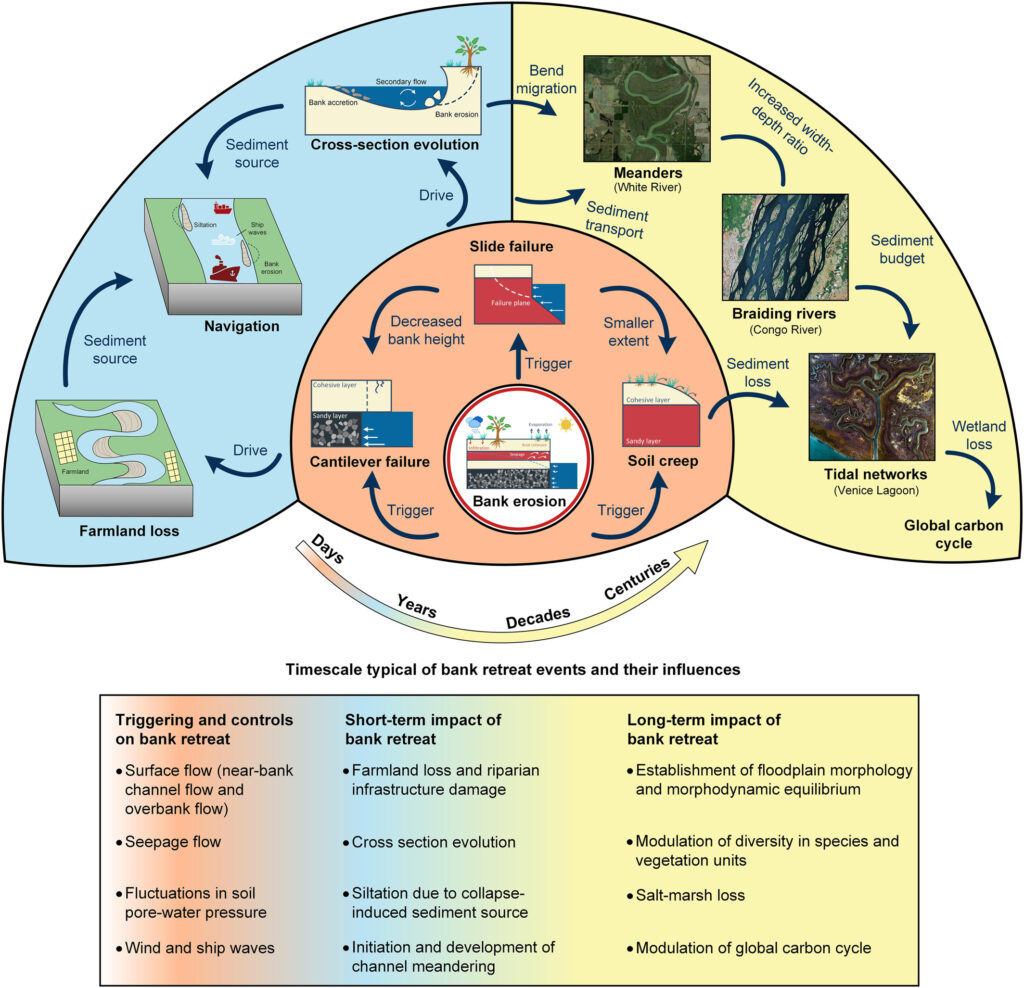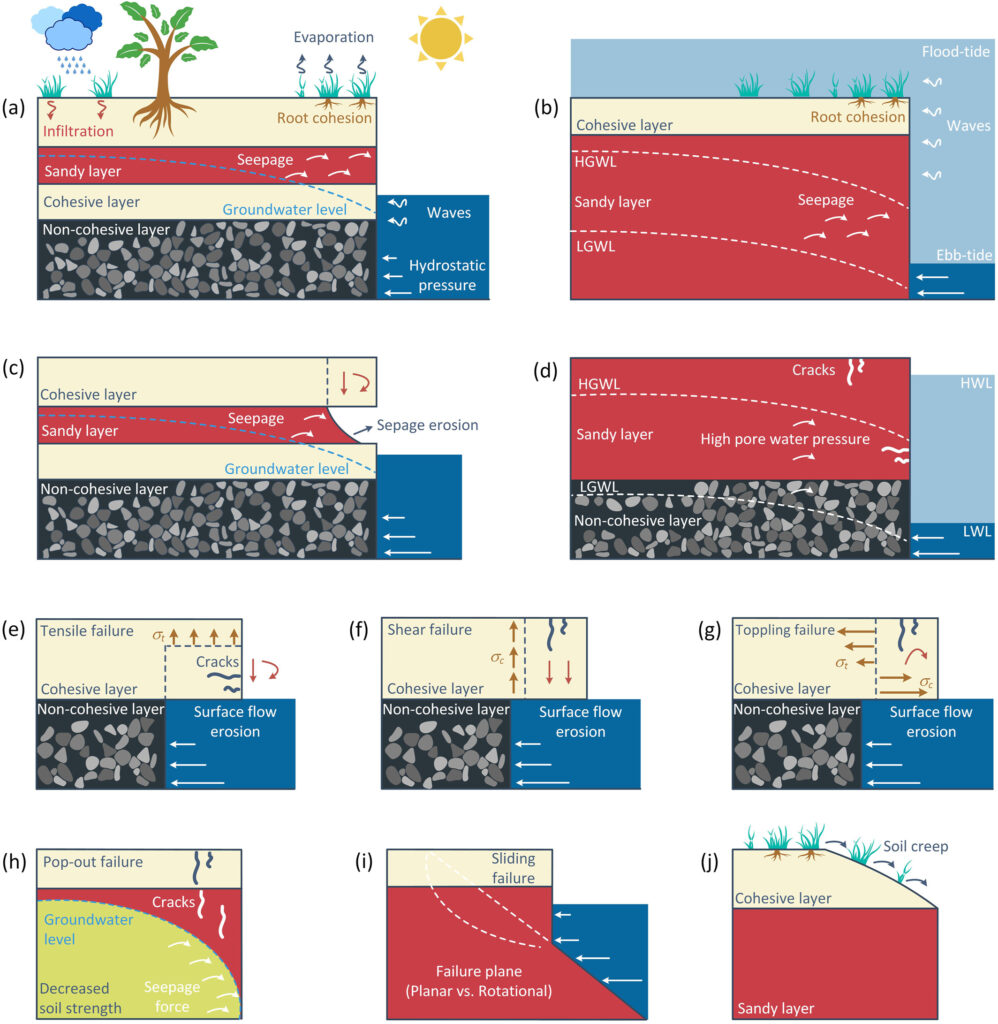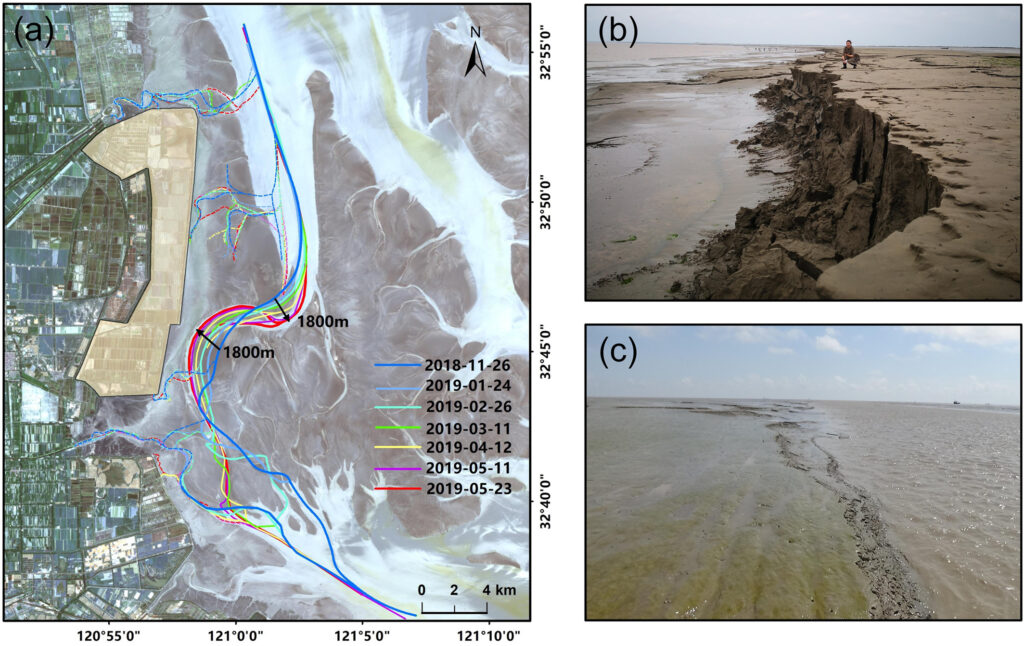Editors’ Vox is a blog from AGU’s Publications Department.
Bank retreat is one of the most consistent processes that shape rivers, estuaries, and coastal regions around the globe. Therefore, understanding and predicting bank retreat is vital for water resource management and the protection of wetlands.
A recent article in Reviews of Geophysics explores bank retreat processes in both river and tidal environments. Here, we asked some of the authors to explain the fundamentals of bank retreat, developments in modeling, and what research questions remain.
In simple terms, what is “bank retreat” and why is it important to understand?
Bank retreat results from the detachment of bank soil (rock and/or ice) under the actions of hydraulic and gravitational forces, subaerial processes, bioturbation, as well as resisting actions that depend on soil properties, possibly mediated by vegetation cover. Bank retreat is observed in a wide range of settings including rivers, gullies, tidal channels, salt marsh borders, and marine-ice landscapes.
As one of the most persistent and dominant processes that shape rivers, estuaries, and coastal regions, bank retreat is of great relevance to the management of water courses and the protection of wetlands. For some tributaries of the Yangtze River, the retreat distance induced by individual bank collapse events reaches up to 500 meters per day, threatening safety of lives, properties, and infrastructure. From an ecological perspective, bank retreat provides sediment supply to create habitats on a floodplain and over channel bars, affects nutrient and contaminant, modulates the diversity of species and vegetation units, induces salt-marsh loss; and so, modulates the global carbon cycle.

What are the main factors that influence bank retreat?
Generally, bank retreat is caused by flow-driven particle-by-particle erosion (flow-driven bank erosion) and gravity-driven mass failure (bank collapse). Flow-driven bank erosion consists of the removal of bank material under the direct action of water flow (near-bank channel flow, over-bank flow, seepage flow), and can be enhanced by subaerial processes. Bank collapse, in contrast, occurs when the forces that tend to move soil downslope (soil weight, seepage forces, and excess pore water pressure) exceed the resisting forces of the bank (cohesion imparted by the soil and root matrix, matric suction, and hydrostatic pressure head). Unlike the continuous, progressive, nature of flow-driven bank erosion, bank collapse is episodic and is associated with various modes of failure, including shear, tensile, and toppling, that depend on bank soil properties, bank height, near-bank water depth, and the presence of vegetation.

How do scientists measure bank retreat?
Scientists apply different methods to measure bank retreat, which depend on the required resolution and timescale of interest. Sedimentological analyses by means of sediment cores sampling are suitable for detecting low-resolution channel change over timescales of hundreds to thousands of years. For large scale rivers, tidal channels and gullies systems, bank retreat distance can be easily acquired through sequential satellite images. Because of the limited resolution and since the visibility of satellite images is often impeded by clouds, this method should only be applied to analyze bank retreat processes over timescales ranging from years to decades. For seasonal to daily timescale, Real-Time Kinematic positioning (RTK) and erosion pins (a rod fixed into the bank timely recording its exposed length) are widely used for bank profile measurement. More recently, Terrestrial Laser Scanning (TLS) and Unmanned Aerial Vehicle (UAV) have been adopted by the scientific community for high-resolution monitoring of bank retreat.
What are some of the recent developments in bank retreat modeling?
Studies carried out to model bank retreat have followed two distinct paths: a hydraulic approach and a geotechnical approach. The former approach describes bank retreat from a hydraulic perspective, usually by means of surrogates of the shear stress that the flow exerts on the bank, while the geotechnical approach focuses on the transient process of bank collapse.
Recently, scientists have been trying to clarify how bank collapse events affect the long-term evolution of rivers and tidal channels developing empirical parameterizations, based on field and experimental data. For instance, recent modeling indicates that the flow-induced bank erosion rate is amplified by the contribution of bank collapse to bank retreat, which depends on the ratio of bank height to near-bank water depth. Machine learning algorithms based on large datasets have also been applied to develop predictors of bank retreat rate. Since the factors dominating surface flow are relatively easy to collect (e.g., precipitation, drainage area, and soil characteristics), larger datasets are becoming increasingly available so that machine learning is likely to improve our predictive skill of bank retreat rates.
Why has more research historically focused on river environments rather than tidal environments?
Rivers distribute worldwide and are central to the development of civilization as more than 2.7 billion people live around a floodplain. Therefore, studying riverbank retreat holds huge socio-economic repercussions. In contrast, bank retreat in tidal environments has received relatively little attention until recent decades, when numerous seawalls and offshore wind structures were built. The rapid and frequent migration of tidal meanders can potentially cause damage to such coastal infrastructures, hence the need to better understand and predict bank retreat also matters in tidal environments. At the same time, available data to analyze bank retreat of tidal channels remains relatively rare as compared to their fluvial counterparts. The lack of field data, partly due to the difficulties in collecting measurements, has precluded further insights and understanding of bank retreat in tidal environments.

What are the major unsolved questions or knowledge gaps where additional research, data or modeling efforts are needed?
In our review article, three challenges are discussed that deserve attention in order to improve our fundamental understanding of bank retreat processes. The first challenge is to unravel the complex mechanism related to multifactor-driven bank retreat in both fluvial and tidal environments, with particular attention to the interactions between hydrodynamics, soil properties, and biological processes. The second challenge is to clarify whether the assessment of bank retreat in fluvial and tidal environments needs somewhat ad hoc approaches, given the different temporal and spatial scales operating in these distinct settings. The last issue is associated with the fate of slump blocks, and how more field observations are needed to evaluate the role that slump blocks have on channel morphodynamics, feedback on bank retreat, hydrodynamics, and sediment dynamics.
—Kun Zhao ([email protected]; ![]() 0000-0001-9259-8182), Hohai University, China; Giovanni Coco (
0000-0001-9259-8182), Hohai University, China; Giovanni Coco (![]() 0000-0001-7435-1602), University of Auckland, New Zealand; Zheng Gong (
0000-0001-7435-1602), University of Auckland, New Zealand; Zheng Gong (![]() 0000-0001-8803-1140), Hohai University, China; Stephen E. Darby (
0000-0001-8803-1140), Hohai University, China; Stephen E. Darby (![]() 0000-0001-8778-4394), University of Southampton, UK; Stefano Lanzoni (
0000-0001-8778-4394), University of Southampton, UK; Stefano Lanzoni (![]() 0000-0002-6621-2386), University of Padua, Italy; Fan Xu (
0000-0002-6621-2386), University of Padua, Italy; Fan Xu (![]() 0000-0001-5820-4717), East China Normal University, China; Kaili Zhang (
0000-0001-5820-4717), East China Normal University, China; Kaili Zhang (![]() 0000-0002-2717-0638), Hohai University, China; and Ian Townend (
0000-0002-2717-0638), Hohai University, China; and Ian Townend (![]() 0000-0003-2101-3858), University of Southampton, UK.
0000-0003-2101-3858), University of Southampton, UK.
Editor’s Note: It is the policy of AGU Publications to invite the authors of articles published in Reviews of Geophysics to write a summary for Eos Editors’ Vox.

